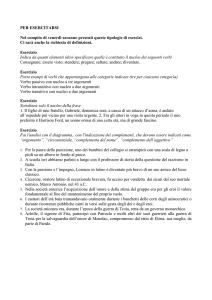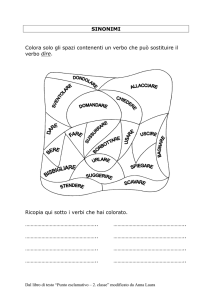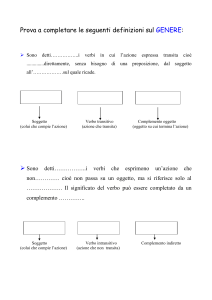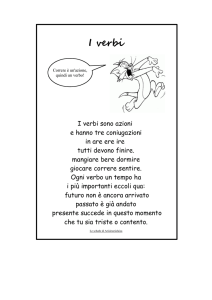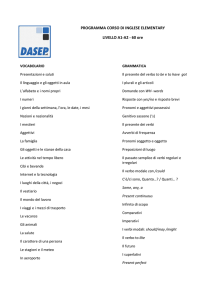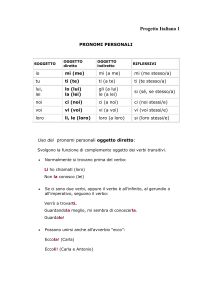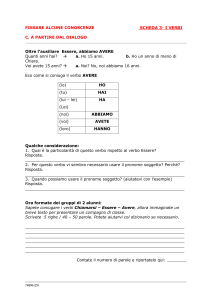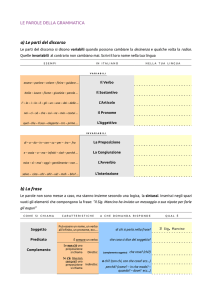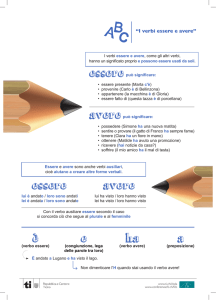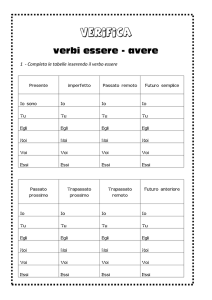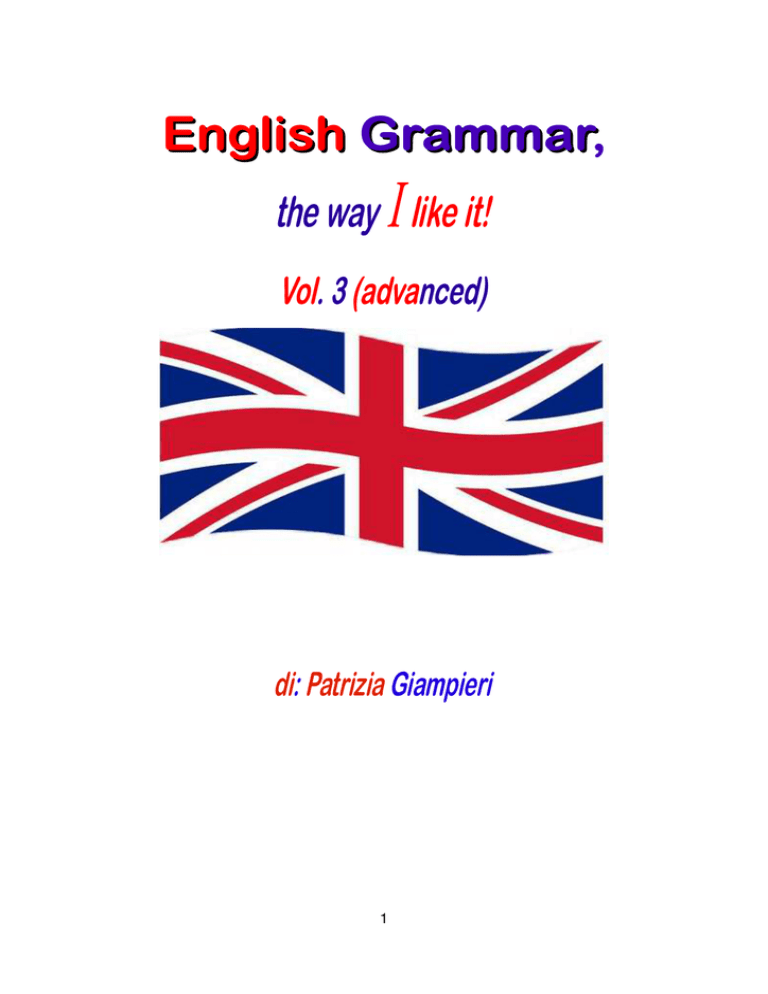
English Grammar,
Grammar
I
the way like it!
Vol. 3 (advanced)
di: Patrizia Giampieri
1
INTRODUZIONE
Questo ebook presenta la grammatica inglese a livello avanzato.
Ogni capitolo: introduce, spiega l'argomento e propone una serie di esercizi.
Le soluzioni sono disponibili in un volume a parte.
BUON LAVORO!
Questo volume può essere liberamente consultato ed utilizzato,
purché vengano citati il titolo e l'autrice
2
INDICE
VERBS (+ OBJECTS) + PREPOSITIONS
PHRASAL VERBS
COMPOUND WORDS
LINKING WORDS
PUNCTUATION
COHESION
3
VERBS (+ OBJECT) + PREPOSITIONS
VERBS + PREPOSITIONS
Spesso alcuni verbi in Inglese sono retti da una preposizione, come del resto in Italiano:
-I'll sit on this chair,if you don't mind=mi siedo/siederò su questa sedia, se non ti dispiace
-I live at 5, Reed Str., WEC2 London=vivo in Reed Street, WEC2 Londra
-I want to participate in this project!=voglio partecipare a questo progetto!
Se la preposizione è “to”, questa può introdurre un complimento di termine:
-write to me soon!=scrivimi presto!
-I love listening to classical music=adoro ascoltare la musica classica (in Italiano non abbiamo una
preposizione né un complemento di termine, ma un complemento oggetto)
-talk to me!=parlami!
-did you speak to anyone?=hai parlato a/con nessuno?
-this will help you to focus=questo ti aiuterà a concentrarti (con il verbo help “to” può essere anche
omesso=>this will help you focus)
Alcuni verbi sono i seguenti:
VERBO
TRADUZIONE
apply for
far domanda
FRASE-tipo
To apply for a job
apologize for/to
chiedere scusa a qualcuno per I apologized to Tom for my bad
qualcosa
behaviour
ask for
chiedere/richiedere (di)
Did you ask for Sally?
believe in
credere in/a
Do you believe in coincidences?
complain about/to
lamentarsi con qualcuno di/per
qualcosa
I complained to the manager about
the bad service
concentrate on, focus on concentrarsi su
I must concentrate on this exercise
depend on
dipendere da
This depends on many factors
pay for
pagare
Did you pay for the dinner?
participate in
take part in
partecipare a
She's going to take part in our
campaign
speak/talk to/with
parlare a/con qualcuno
Did you speak to Mary yesterday?
wait for
attendere qualcuno
I've been waiting for you!
write to*
scrivere a qualcuno
*L'inglese americano non ha il “to”=> write me!
Write to me, OK?
VERBS + OBJECT + PREPOSITIONS
Alcuni verbi sono seguiti da un complemento oggetto, poi da una preposizione, (SOGGETTO +
VERBO + C.OGGETTO + PREPOSIZIONE =S+V+CO+P), come nell'esempio put that dress on!
Alcune volte, è possibile invertire le posizioni della preposizione e del complemento oggetto (S+V
+P+CO), come nell'esempio seguente: put that dress on! = put on that dress!
PUT
Il verbo PUT significa mettere; “put on” significa indossare (ma anche ingrassare “put on weight”,
insieme ad altri significati: “put on a show”,organizzare etc..)
4
Prendendo come significato quello di “indossare”, nota la costruzione:
-I'll put on that dress (S+V+P+CO)> I'll put that dress on (S+V+CO+P)=indosserò quell'abito.
La preposizione ON può praticamente precedere o seguire il complemento oggetto, tranne quando
questo è espresso da un pronome. In questo caso, la preposizione segue sempre il pronome:
-I'll put it on=lo indosserò (I'll put on it) (S+V+COpr+P)
Molti altri verbi hanno la stessa costruzione di PUT ON, come, ad esempio: TURN OFF , SWITCH
OFF (spegnere); TAKE OFF (solo nel significato di levare di dosso); BREAK DOWN (rompersimacchinari, macchine, etc. spesso intransitivo); THROW AWAY (buttare via); PUT OUT (spegnere
– fuoco); etc.
Tali verbi sono anche detti “verbi frasali”. I verbi frasali sono espressioni idiomatiche e la
preposizione che li segue a volte ne stravolge il significato (vedere l'unità dedicata).
GIVE
give è un verbo particolare perché è retto da due complementi (complemento oggetto CO e
complemento di termine CT). Studia le frasi:
-give that book to Tom!=dai quel libro a Tom!
V + CO + P + CT
-give Tom that book!=da a Tom quel libro (la preposizione TO cade)
V + P + CT + CO
Se ora sostituiamo “that book” e “Tom” con i rispettivi pronomi...:
give that book to him! (V+CO+P+CTpr)> give him that book! (V+CTpr+CO)=cade TO
give it to Tom! (V+CO+P+CT)
Se tuttavia i pronomi sono doppi, la composizione della frase è fissa:
give it to him! (V+CO+P+CTpr) (in quest'ultimo caso non è possibile cambiare la posizione di
HIM: give to him it)
Altre volte, i verbi hanno delle costruzioni diverse dalle nostre. Vediamo alcuni verbi particolari:
WANT
Diversamente dall'italiano, che vuole una costruzione “volere + che + congiuntivo”, in Inglese want
è seguito da:
1)TO + VERBO => I want to come to the party=voglio venire alla festa
2)CO + TO + VERBO F.B. =>I want you to stay calm=voglio che tu stia calmo
Si comportano come WANT questi altri verbi: ASK, EXPECT, WOULD LIKE, WOULD PREFER,
RECOMMEND*
(*recommend si comporta anche come suggest, vedi sotto)
SUGGEST
Questo verbo può essere seguito:
1)VERB-ING quando seguito solo dal verbo =>I suggest taking the underground=suggerisco di
prendere la metro
2)THAT + CO + VERBO se regge un complemento oggetto =>I suggest that you talk to your
mother=ti suggerisco di parlare a tua madre (suggerisco che tu parli..)
Si comportano come SUGGEST questi altri verbi: RECOMMEND*, INSIST, DEMAND,
PROPOSE
(*recommend si comporta anche come want)
ALLOW
Questo verbo può essere seguito da:
1)VERB-ING quando seguito solo dal verbo => they don't allow smoking here=non permettono di
5
fumare qui
2)CO + TO + VERBO F.B. quando seguito da un complemento oggetto => he allows us to go=ci
permette di andare
Si comportano come ALLOW questi altri verbi: RECOMMEND, ENCOURAGE, ADVISE,
PERMIT
Altri verbi hanno invece la costruzione S+V+CO(+NOT)+TO+V.
Questi verbi sono: TELL, REMIND, ENABLE, PERSUADE, INVITE, WARN, ORDER, FORCE.
ESEMPI
-she told me to go=mi disse di andare
-she persuaded me not to go=mi persuase a non andare
ESERCIZI
Esercizio 1
Forma delle frasi usando il verbo want
1.Sarah was sad when Tom left.
Sarah/want/stay
2.Paul was told about the surprise party. His friends were unhappy.
Paul's friends/not want/know
3.Lisa plays volleyball. She will play next Saturday. Her parents ask her..
you/your team/win/?
Esercizio 2
Forma delle frasi sulla base del verbo indicato. Il significato non deve cambiare
1.Jim says: “it would be better if you stayed home today”
Jim advised____________
2.Ann says: “it's better if you read that article”
Ann suggests___________
3.Tom says: “with this car, you'll go very fast!”
That car will enable___________
4.Peter says. “don't touch that cable; it's dangerous”
Peter warned___________
5.Ann says “if you study more, you'll get higher marks”
Ann recommends____________
6.Jack says: “I would be really happy if you stayed longer”
Jack insists_________
7.Fiona didn't let us go out yesterday night.
Fiona didn't allow___________
8.Paul says “come to my party”
Paul invites___________
Esercizio 3
Tradurre le frasi seguenti
1.Suzanne ieri ha dato un libro a Tom, che non gliel'ha ancora ridato.
2.Mettiti le scarpe ed usciamo! Presto.
Le ho già messe, non vedi?
3.Spegni la luce per piacere e ricordati di mettere (to set) la sveglia!
4.Non voglio che tu vada al cinema con Paul. Non mi piace come parla.
Ma al cinema non parliamo mica.
6
5.Ieri la macchina si è rotta ed ho dovuto chiamare il meccanico. L'ho dovuto aspettare sotto la
pioggia.
Perché? Non potevi aspettarlo dentro la macchina?
6.Sono stufo di (to be fed up with) dover pagare tutti i tuoi libri inutili! È ora che ti trovi un lavoro.
7.Ti chiedo scusa per tutto il baccano che abbiamo fatto ieri notte.
Non preoccuparti! La prossima volta chiamami, che voglio partecipare alle tue feste.
8.Devi concentrarti di più sui tuoi obiettivi, se vuoi laurearti.
Esercizio 4
Termina le seguenti frasi inserendo negli spazi vuoti i verbi indicati nel riquadro (che vanno
coniugati). Ciascun verbo può essere inserito più volte.
Inserisci anche le preposizioni/congiunzioni al posto dei puntini. Le preposizioni sono indicate nel
riquadro più in basso. Alcune preposizioni possono essere inserite più volte.
advise, ask, expect, suggest, take, wait, want, write (da inserire negli spazi vuoti)
for, off, that, to (da inserire al posto dei puntini)
1.It's so hot in here! Do you mind if I ___ my jumper …..? No, please do.
2.I really enjoyed my holiday because I met Sally. I will ___ ….. her as soon as I get home.
3.We were ___ you …. come for dinner. It's a pity you couldn't make it.
4.Before ___ ….., we kindly remind you to fasten your seatbelts.
5.I need to go to the tourist office and ___ …. more information.
6.You can ___ here …. her! It won't take long.
7.My mother ___ …. we take a bath because we're dirty.
8.We ___ you …. go on holiday now, before it's too late!
9.I don't ___ the kids …. be late tonight! At 8 they must be home.
7
PHRASAL VERBS
I verbi frasali sono dei verbi seguiti da una o più preposizioni, o da un avverbio, che ne possono
cambiare il significato. Per questo motivo, possono divenire delle espressioni idiomatiche a sé.
Alcune volte il significato è quasi immediato:
I'll pick up some flowers for you = raccoglierò dei fiori per te
Altre volte, purtroppo, non è sempre possibile capire il significato del verbo traducendo la
preposizione o l'avverbio che lo seguono. È quindi necessario impararli a memoria man mano che si
“incontrano”. La preposizione o l'avverbio che seguono un verbo, possono infatti alterare
notevolmente il significato del verbo principale:
ESEMPIO: TURN=girare
-turn up the radio! = alza (il volume del)la radio!
-turn around, I want to see you in that dress! = girati, voglio vederti con quel vestito (addosso)
-the thief was finally turned in= il ladro fu finalmente consegnato alla polizia
Alcune volte la stessa preposizione (o lo stesso avverbio) possono attribuire più significati al verbo
principale:
-turn up the radio! = alza (il volume del)la radio!
-did Simon turn up? = Simon si è fatto vivo?
-I put on some weight recently = mi sono ingrassato di recente
-they put on a great show = hanno organizzato (messo sù) uno spettacolo eccezionale
-put on the red dress = mettiti (indossa) l'abito rosso
1.SPIEGAZIONE COMPLETA (E COMPLESSA) DEI PHRASAL VERBS
Come accennato, il verbo può essere seguito da una preposizione, da un avverbio o da un avverbio
ed una preposizione. Analizziamoli nel dettaglio:
VERB+PREPOSITION
Il verbo frasale costruito con una preposizione ha quasi sempre un complemento oggetto, che va
posto sempre dopo la preposizione.
Questo significa che il verbo e la preposizione sono inseparabili:
-look after your sister please => look after her, please (look your sister after; look her after)
-I'll look into this matter, ok? => I'll look into it =>(look into=investigate)
VERB+PREPOSITION+OBJECT
VERB+ADVERB
1.Il verbo frasale seguito da un avverbio non sempre è seguito da un complemento oggetto (ovvero
può essere un verbo intransitivo):
-let's get together one of these days! =>(get together=meet)
-please carry on without me =>(carry on=continue)
2.Se c'è un complemento oggetto, questo può esser messo prima o dopo l'avverbio:
-Susan called off the meeting => Susan called the meeting off =>(call off=cancel)
-I looked up the word in the dictionary => I looked the word up in the dictionary =>(look
up=search, but only in a dictionary/book etc.)
VERB+ADVERB+OBJECT ;
VERB+OBJECT+ADVERB
8
3.Se il complemento oggetto è un pronome, questo deve essere posto prima dell'avverbio, quindi il
verbo e l'avverbio sono sempre separati:
-Susan called it off
VERB+PR.OBJECT+ADVERB
4.Se il complemento oggetto è molto lungo, questo va posto generalmente dopo l'avverbio, quindi il
verbo e l'avverbio diventano inseparabili:
-Susan called off the meeting which was urgent
-Susan called off the meeting we were talking about yesterday
VERB+ADVERB+LONG OBJECT
VERB+ADVERB+PREPOSITION
Se il verbo frasale ha un complemento oggetto (ovvero se è transitivo), quest'ultimo generalmente
segue l'avverbio e la preposizione. Ciò vuol dire che il verbo + avverbio + preposizione sono
inseparabili, anche se il complemento oggetto è espresso da un pronome:
-they came up with a new line of products =>(come up with=excogitate, find)
-I'm fed up with his behaviour =>(fed up with=cannot stand, cannot tolerate)
-He got on (very) well with them (to get on well with= andare d'accordo)
-She always gets away with it! (to get away with it=cavarsela senza esser puniti)
VERB+ADVERB+PREPOSITION+OBJECT;
VERB+ADVERB+PREPOSITION+PR.OBJECT
2.SPIEGAZIONE PIÙ IMMEDIATA DEI PHRASAL VERBS
In realtà, non è tanto importante sapere se un verbo è sequito da un avverbio o da una preposizione
(che, per semplicità, potremmo chiamare “particelle”), anche perché spesso alcune particelle sono
sia avverbi che preposizioni (come: up, off, over, down, etc.), quindi dovremmo capire quando una
particella è l'una o l'altra cosa.
Piuttosto, è importante sapere:
1.il significato dei verbi frasali (che si può memorizzare di volta in volta)
2.che alcuni verbi frasali sono intransitivi, ovvero non sono mai seguiti da un complemento oggetto
3.che alcuni verbi frasali transitivi sono “separabili”, ovvero ammettono il complemento oggetto tra
il verbo e l'avverbio
Segue una spiegazione più “rapida” ed immediata dei phrasal verbs:
VERBO+PARTICELLA (INTRANSITIVO)
grow up=crescere
hang out=frequentare
take off=decollare
wake up=svegliarsi
ESEMPI:
-children grow up fast!
-when are we going to take off?
-I need to wake up early tomorrow
VERBO+COMPLEMENTO OGGETTO+PARTICELLA (SEPARABILE)
bring up=educare
9
call off=cancellare, disdire
find out=scoprire, trovare
hand in=consegnare a mano
let down=deludere
make up=inventare
put off=posporre, rinviare
sort out=risolvere
take off=togliersi di dosso (abiti)
throw away=buttare via
wake up=svegliare
ESEMPI:
-It's difficult to bring up children today
-don't make up stories! You're late as usual, and that's it.
-I need to sort out this issue as soon as possible OR: I need to sort this issue out as soon as possible
-Please, take off your shoes.. Yes, take them off.
-Could you wake me up tomorrow morning at 7?
VERBO+PARTICELLA+COMPLEMENTO OGGETTO (NON SEPARABILE)
bring about=causare, determinare
come across=incontrare per caso
deal with=trattare, avere a che fare
get over=superare, guarire
ESEMPI:
-I came across David yesterday. He looked gorgeous!
-Do I have to deal with this matter by myself?
-I'm sure you'll get over this difficult situation.
RACCOMANDAZIONI
1.Il modo migliore per apprendere i verbi frasali, come detto sopra, è di memorizzarli (e
memorizzare il “contesto” in cui vengono usati) man mano che si incontrano.
2.Nell'inglese letterario, accademico, ed in tutti quei contesti in cui si richiede un certo “registro”, il
phrasal verb va sostituito dal corrispondente verbo più formale. Esempi:
come back to => return;
get out from => exit, etc.
ESERCIZI
Esercizio 1
Scrivi, o trova nel vocabolario le traduzioni dei seguenti verbi frasali:
to carry on (+verb-ing)
to dream about
to dream of (something, someone)
to fill in (to fill out=American English)
to get into (a car)
to get off (a bus)
10
to get on (a bus)
to get on very well with
to get out of (a car)
to give away
to give up (+verb-ing)
to laugh at (someone)
to look after (someone)
to look at (something/someone)
to look for (something)
to look forward to (+verb-ing)
to pick up
to rely on (someone)
to show off
to think about
to think of
to try on
to wait for (someone)
to wake up
to write down
Esercizio 2
Scegli il verbo frasale giusto ed inseriscilo nelle frasi. Scrivilo al tempo verbale corretto, in base al
contesto
break down, clear up, close down, give up, put out, speak up, try on, turn on, turn up, write down
1.She asked me to _____ my address.
2.They were cold, so we _____ the heating.
3.They were all non-smokers, so I _____ my cigarettes
4.I used to buy chocolates in a shop in the High Street, but it ______ last year.
5.What horrible weather! -Don't worry! It ______ later on!
6.My father used to smoke, but he _____ when I was born.
7.Nobody _____ at Virginia's party. It was such an embarrassment.
8.Our car _____ in the middle of the motorway yesterday.
9.She can't hear you very well, please ____.
10.I'll buy a new pair of trousers, but before I'll ___(them)___
Esercizio 3
Collegare i verbi della colonna di sinistra con le rispettive spiegazioni della colonna di destra:
TO GET...
-out (of)
to click
-on
to continue
11
-in
to enter
-on well with
to enter, to go inside
-together
to exit
-off (a bus)
to exit
-into (a car)
to go beyond
-over (a difficult time/an illness)
to manage, to succeed
-through
to meet
TO BE...
-up to
not to work on that day
-around
to be out
-away
to be without (something)
-out of
to be/remain in the proximity
-off
to plan, to do something
TO RUN...
-away
not to have (anymore)
-after (someone)
to escape
-out of
to chase
-into
to bump into, to collide with (someone)
TO PUT...
-on
-to extinguish
-up with
-to host
-up (for the night)
-to postpone
-off
-to replace, to put back
-out (fire/a cigarette)
-to tolerate, to stand
-away
-to wear
Esercizio 4
Trova le preposizioni giuste che seguono il verbo, per ottenere il significato indicato tra parentesi:
TO LOOK...
-______ (=to take care of)
-______ (=can't wait to)
-______ (in a dictionary) (=to search for words in a dictionary)
-______ (=to search)
-______ (=to investigate)
TO TAKE...
-______ (=to look like)
12
-______(=to increase sharply, OR to get undressed)
-______ (=to take someone else's work)
-______ (=to invite for dinner)
TO TALK...
-______ (=to discuss in order to make things clear)
-______ (=to discuss something)
-______ (=to chat with somebody)
Esercizio 5
Traduci e, quando possibile, trova dei sinonimi in Inglese dei seguenti verbi frasali:
TO TURN...
-in =....
-around =.....
-up =.....
TO STAND...
-up for=...
-up=....
TO CALL...
-off=....
-back=....
13
COMPOUND WORDS
Le “compound words” sono delle parole composte.
COMPOUND NOUNS
Ad esempio, alcuni compound nouns, "gruppi nominali" (detti anche noun phrases) sono parole
composte da nomi, nelle quali uno funge da "aggettivo", ovvero qualifica l'altro. In Italiano
abbiamo qualche esempio:
-una “riunione lampo” >> sto parlando di una riunione o di un lampo? È ovvio che sto parlando di
una riunione, che è stata organizzata con così poco preavviso da sembrare un "lampo". Ecco quindi
che "lampo" ha qualificato (ha dato informazioni su) la riunione.
In Inglese i casi sono molto più frequenti e si usano, ad esempio, quando non è ammesso il genitivo
(quindi sostanzialmente per descrivere le cose). Si costruiscono mettendo prima il nome che funge
da aggettivo (quindi che qualifica), poi il nome vero e proprio (quello di cui stiamo parlando, nel
caso sopra: la riunione). Come tutti gli aggettivi, il nome che precede quello vero e proprio è solo al
singolare:
-the book cover>>the cover of the book=la copertina del libro
-the book covers>>the covers of the book(s)=le copertine dei libri OPPURE le copertine del libro
-the computer room>>the room with the computers=l'aula di informatica (l'aula dei computer)
Per capire di che cosa stiamo parlando, dobbiamo quindi far riferimento all'ultima parola del
gruppo. Nei casi sopra: cover, covers, room.
I compound nouns si compongono da:
-NOME + NOME => bus station, chatroom (o chat room; chat-room, vedi l'argomento seguente
“hyphens”)
-AGGETTIVO + NOME => personal computer
-NOME + PREPOSIZIONE => passer-by
SUGGERIMENTI
1.I compound words composti da nomi, si leggono “alla rovescia”, partendo dall'ultimo nome che
compone il gruppo. Poi, nel leggerli, si introduce una preposizione (DI, SU... semplici o articolate):
-the book cover = la copertina del libro (..un po' come se si leggesse un genitivo, ma senza 's)
-a technology-driven society = una società basata/fondata sulla tecnologia (=tecnologica)
2.È chiaro che il nome (o il gruppo di parole) che precede un nome si “comporta” da aggettivo,
quindi non è scritto al plurale!
3.È possibile infine trovare dei participi presenti, ovvero verbi in ING, che precedono un nome.
Questi participi presenti, tuttavia, non fungono altro che da AGGETTIVI. Ecco quindi che si ricade
nell'esempio riportato sopra:
-driving licence (=patente di guida)
-cutting board (=tagliere)
-living room
HYPHENS
1.In passato, la maggior parte dei compound nouns richiedeva un trattino (detto hyphen). Oggi, si
predilige scrivere le parole separatamente o addirittura unirle, come nei casi seguenti, in cui tutte e
tre le forme sono “ammesse”:
-chat room, chat-room, chatroom
-play group, play-group, playgroup
14
e tante altre..
2.Tuttavia, alcune regole sono rimaste. Il trattino si usa sempre:
-per i compound nouns formati da verbi frasali => turn-over, built-in (Attenzione! Si tratta di
sostantivi, non verbi!)
-nei compound nouns composti da una o più parole eventualmente unite da
preposizioni/congiunzioni => mother-in-law; buy-and-sell, passer-by
-nei compound nouns composti da più parole se precedono il nome principale (saranno scritti senza
trattino se lo seguono) => up-to-date research (=ma=> this research is up to date); down-to-earth
values (=ma=> his values are down to earth)
3.Attenzione! Alcune volte il significato del compound noun potrebbe variare proprio in ragione del
trattino:
-a paper-cutter = un tagliacarte
-a paper cutter = un coltello di... carta
-an orange-box = una scatola di arance
-an orange box = una scatola color arancione
Il trattino in pratica mette in chiaro chiaro che cosa va “modificato”, ovvero quale parola va
“qualificata”. Leggi gli esempi che seguono per capire meglio:
1.There are some beautiful-looking people over there.
2.There are some beautiful looking people over there.
Nel primo caso, beautiful si riferisce a (ovvero modifica o qualifica) looking. La frase va quindi
tradotta: laggiù ci sono delle persone meravigliose/bellissime.
Nel secondo caso, beautiful potrebbe riferirsi a looking people (gente che guarda), quindi la frase
potrebbe essere tradotta: laggiù ci sono delle belle persone che guardano
COMPOUND ADJECTIVES
A volte si possono scrivere compound words con funzione di aggettivi. In tal caso, si parla di
compound adjectives. Possiamo avere diversi casi di compound adjectives, ovvero parole composte
da:
1.NOME +AGGETTIVO
2.AGGETTIVO o AVVERBIO + PARTICIPIO PASSATO ; NOME + PARTICIPIO PASSATO
3.AGGETTIVO o NUMERO + NOME in -ED
4.AGGETTIVO o NOME o AVVERBIO + PARTICIPIO PRESENTE
1.NOME-AGGETTIVO
La maggior parte delle volte, i nomi sono preceduti da aggettivi, come in:
-mobile phone (=cellulare)
In alcuni compound adjectives, che fungono da aggettivi, prima c'è un nome, poi un aggettivo. In
questi casi, le parole sono unite da un hyphen “-”, o trattino breve:
-please use a gender-neutral language => “gender-neutral” è un gruppo di parole aggettivate,
composto da un nome (gender) ed un aggettivo (neutral).
Come è possibile vedere, il gruppo di parole unite dal trattino precede un altro nome.
2a.AGGETTIVO / AVVERBIO -PARTICIPIO PASSATO
I participi passati generalmente precedono un nome:
-there are always complicated relationships at work
-the exhausted survivors told us the true story
Tuttavia, nei compound adjectives il participio passato (verbo in -ED, o alla terza colonna se
15
irregolare) segue il nome. In questi casi, tra il nome ed il participio passato, si mette un hyphen “-”,
o trattino breve:
-a close-minded person
-a well-known thief
Come è possibile vedere, il gruppo di parole unite dal trattino precede un altro nome.
Con well, è possibile evitare il trattino se il compound adjective non precede un nome:
-that thief is well known.
2b.NOME-PARTICIPIO PASSATO:
In questo caso, si ha un sostantivo unito da un trattino ad un participio passato. Entrambi formano
un compoud adjective, che precede un altro nome (quello principale):
-a computer-based system
-a technology-driven society
Nel caso sopra: “computer-aided”, nome+participio, precede il nome principale “system”.
3.AGGETTIVO / NUMERO -NOME(-ED):
In questo caso, il compound adjective è composto da un aggettivo o da un numero unito da un
trattino ad un nome che termina “artificialmente” in ED:
-the bad-tempered man
-the blue-eyed woman
-she found a one-eyed cat
Le due parole unite dal trattino precedono il nome principale (negli esempi: man, woman, cat); sono
quindi un gruppo aggettivato.
Con i numeri si possono avere anche altri casi particolari. Notare, ad esempio, la frase seguente:
-he's a thirteen-year-old boy => “thirteen-year-old” è chiaramente un intero gruppo di parole
aggettivate, quindi unite dal trattino.
Quando queste parole non precedono un nome, si scrivono senza trattino.
-that boy is thirteen year old
Notare anche le seguenti peculiarità nelle espressioni di tempo:
-it was a twenty-minute presentation => “twenty-minute” è un gruppo composto da due parole
aggettivate. In questo caso, sarebbe stato possibile usare il genitivo anziché il gruppo di parole. Le
espressioni di tempo, si rammenta, ammettono infatti il possessive case:
-it was a twenty minute's presentation
4.AGGETTIVO / NOME / AVVERBIO -PARTICIPIO PRESENTE
I compound adjectives possono essere composti infine da un aggettivo, un nome o da un avverbio
seguito da un participio presente (verbo in ING). Le due parole debbono essere unite dal trattino:
-he is a very good-looking man
-this project has far-reaching implications
-she's a men-cheating girl
-he has a friendly-sounding voice
-she's a motherly-looking woman
COMPOUND VERBS
I compound verbs sono parole composte da:
-VERBO + VERBO => to cross-examine, to hitch-hike..
-NOME + VERBO => to baby-sit, to roller-skate..
La maggior parte è scritta con un trattino, ma, in ragione dei cambiamenti nella lingua, si possono
16
trovare scritti con uno spazio o addirittura attaccati: to rollerskate, to baby sit...
RIEPILOGO HYPHEN
Quando si usa l'hyphen in sostanza?
Si usa sempre per:
-collegare vari gruppi di parole unite da preposizioni o congiunzioni: brother-in-law
-verbi frasali usati come compound nouns: a stop-over in Bangkok
Normalmente si dovrebbe usare per.
-compound adjectives: good-looking, fast-paced, friendly-sounding
Può essere omesso (sostituito da uno spazio o dalle scrittura congiunta delle due parole) per:
-compound nouns: baby-sitter, baby sitter
-compound verbs: cross-examine, cross examine
ESERCIZI
Esercizio 1
Nelle seguenti frasi, indica se il trattino è necessario tra le parole sottolineate:
1.The girl was standing open mouthed in front of me.
2.Jack is just a computer addict.
3.I hate bad mannered girls.
4.The air crew was very friendly.
5.When I translate, I use computer assisted programmes.
Esercizio 2
Forma le “compound words” con le parole date,
necessario. Le parole sono già state accoppiate.
bed
bus
foot
washing
water
hair
dry
draw
did you see the passer
the green
a truck
I've got a green
I get up at
did you see the paper
first
absent
usando il trattino o unendo le due parole quando
room
stop
ball
machine
tank
cut
cleaning service
backs of a strategy
by?
house effect
load of goods
house (its colour is green)
rise
cutter?
class passengers
minded
Esercizio 3
Completa le frasi seguenti con le compound words nel riquadro. Scegli se mettere o no il trattino.
Alcune parole possono essere usate più volte:
clear cut, fast acting, hardest working, only child, well behaved, wide spreading
1.He's a ______ child
2.You need to take a ____ position!
17
3.Your children are _____
4.He's an _____; he doesn't have any brothers or sisters
5.He's the _____ manager in the company!
6.This was a _____ virus.
7.The medication was ____ and he recovered soon.
18
LINKING WORDS
Per collegare frasi tra loro è necessario usare una serie di linking words o connectives. Ve ne sono
alcune che servono ad esprimere una causa o una conseguenza; altre che servono a dare
informazioni aggiuntive o a metterle in sequenza. In questo capitolo se ne espongono alcune.
FUNZIONE
esprimere causa
LINKING WORDS
due to (this/something),
because of (this/something),
thanks to (this/something),
esprimere conseguenza
therefore,
hence*
for that/this reason,
consequently,
as a consequence,
then
so
thus
introduzione di proposizioni (frasi) avversative
however,
nevertheless,
on the other hand
instead*
on the contrary,
introduzione di proposizioni (frasi) dichiarative, in fact,*
che spiegano o confermano quanto detto
as a matter of fact,
introduzione di informazioni aggiuntive
moreover,
furthermore,
in addition,
for instance,
for example,
esprimere una sequenza
first,
first of all,
at first,
firstly,
secondly,
thirdly,
in conclusion,
to conclude,
finally,
*NOTE
Le linking words, generalmente, si scrivono all'inizio di una frase, eccetto (tra quelle elencate sopra)
hence, instead, in fact che si mettono in “seconda posizione”:
-I hence said that it was very late--> Therefore, I said that it was very late.
-Susanne, instead, preferred not to come-->On the contrary, Susanne preferred not to come.
-There are, in fact, too many people waiting--> As a matter of fact, there are too many people
waiting.
19
È bene iniziare a memorizzare la regola secondo cui la maggior parte delle linking words (per lo
meno quelle che si possono mettere all'inizio di una frase) sono seguite da una virgola e precedute
da un punto o da un punto e virgola (vedere capitolo dedicato alla punteggiatura). Tali regole di
punteggiatura sono rigide.
ESERCIZI
Esercizio 1
Inserisci le linking words e le congiunzioni del riquadro negli spazi vuoti.
and, but, for instance, in fact, in addition, nevertheless,
1.She was very tired. ______, she went straight to bed.
2.He was happy to see me, ______ he didn't say a word.
3.We were very late. _______, the party hadn't started yet.
4.She is very young and intelligent. _______, she's very talented. That's why I hate her.
5.You can always go there and ask for a piece of advice. ______, Sally went there when she split up
with Tom.
6.Come and talk to me. I'm sure you will never regret it _____ you'll forget all your troubles!
Esercizio 2
Correggi le linking words o gli altri avverbi, se sono errati:
1.I was wondering if you could help me, but I'm not so sure that you can..
2.She's too busy to look for someone. Because I proposed myself to her.
3.What do you think of her new car? It's very expensive, because I like it.
4.Instead of the green economy, we can save some money now.
Esercizio 3
Nel testo seguente ci sono molte linking words e congiunzioni. Elimina quelle di troppo.
1.Furthermore, she also said that you looked like an idiot, in that morning suit. Therefore, she thus
said she will never come again to visit you.
2.There are many ways to have fun in Rome. At first, one way is to walk around the shopping area
and eat an Italian ice-cream. In this way, so you can enjoy good food and buy some nice clothes or
accessories.
Esercizio 4
Unisci le due frasi usando una linking word.
1.Sophia hasn't changed her attitude since she went to live with Mary. Mary's attitude has changed
dramatically.
2.Our class is full of students coming from different places in the world. It is multicultural.
3.It was raining heavily. We went outside to feed the street cats.
4.<<I want to watch TV>>
--You do your homework!
5.It was very cold and I was sick. We decided to stay home.
20
PUNCTUATION
La punteggiatura in Inglese si usa in maniera lievemente differente dall'Italiano.
PUNTO
È ovvio che il punto va messo alla fine di una frase, ma non è altrettanto ovvio sapere che in Inglese
le frasi sono generalmente molto più brevi di quelle italiane. È infatti consigliabile scrivere frasi di
20-30 parole. Quando si superano le trenta parole, è bene chiedersi come poter dividere la frase. È
qui che entrano in gioco le “linking words” (vedere il capitolo dedicato), ovvero avverbi,
espressioni e congiunzioni atte a collegare ciascuna frase con l'altra in maniera logica. Tutto ciò
comporta che per scrivere bene, in Inglese, non è necessario costruire frasi con molte subordinate,
ma è bene evitare la discontinuità sintattica (ad esempio, ma faccio un esempio solo ora, una
discontinuità, a volte definita come sintattica, può verificarsi quando, a meno che non vogliate
darle un altro nome, scrivo, se posso permettermi di evidenziarlo senza creare troppe confusioni
nella mente dei lettori, una frase esattamente come questa), ovvero la separazione o
l'allontanamento “esasperato” delle unità principali della frase (soggetto, verbo, complemento/i). La
chiave per scrivere bene è, quindi, la semplicità.
Se in Italiano si scriverebbero frasi del tipo:
-Ieri Pietro e Paola, che sono miei amici da quando avevo 15 anni, hanno festeggiato con me e mia
sorella minore i loro 20 anni di matrimonio nella loro casetta in montagna.
In Inglese dovremmo necessariamente accorciarla. Ecco alcuni suggerimenti:
-Pietro and Paola have been my friends since I was 15. Together with my younger sister, we spent
yesterday their 20th wedding anniversary in their mountain house.
La maggior parte delle linking words, o transitions (vedere il capitolo dedicato), non sono mai
precedute da una virgola, bensì da un punto o da un punto e virgola.
-I don't think it's a good idea. Therefore, I won't follow your advice.
In Inglese non esistono infine i problemi legati alla ridondanza dei termini o alla ripetitività; quando
necessario è possibile ripetere più volte la stessa parola.
VIRGOLA
La virgola:
-si mette tra gli elementi di una lista e tra una serie di aggettivi (eccetto quello prossimo al
sostantivo):
We bought an expensive, red, old car.
-si mette quando è necessario “prendere fiato”, ovvero fare una breve pausa.
I don't know whether I'm coming or not, because I'm very tired.
-si può mettere prima della congiunzione “but”.
You can go out, but don't be late!
-è ammessa prima della congiunzione “and”, purché serva a far fare una pausa al lettore o a
separare elementi:
I think that advancements in research and development, and the low price of our products, are the
main reasons why customers prefer our products.
Nella frase sopra, “research and development” sono due parole che sono generalmente scritte
insieme e non possono essere divise, ma la congiunzione “and” che segue può essere preceduta da
21
una virgola per separare gli elementi del discorso (research and development da una parte, the low
price etc. dall'altra).
-si mette all'inizio ed alla fine di una “non-defining relative clause” (frase a senso compiuto
introdotta da una pronome relativo):
The book, which is on the table, is very old.
-si mette dopo alcuni avverbi o espressioni dette “linking words” o “transitions” (vedere capitolo
dedicato), come: however, therefore, moreover, in addition, for example, firstly, first of all, finally,
in particular etc.
-non si mette mai tra soggetto e verbo, a meno che non ci siano degli “incisi”:
I, the eldest, think that this situation is unbearable for my family.
-non si mette tra soggetto e complemento. In pratica non è comune dividere le unità principali della
frase (soggetto, verbo, complemento)
I'll buy an apple for you, if you give me the money.
DUE PUNTI
I due punti si mettono:
-per elencare una serie di elementi/cose/persone:
At the party we saw many people: Jeff, Jack, Theresa and Mary.
-nel discorso diretto, o nelle citazioni
-She shouted: “No! I can't believe this”
-quando una frase “espande” la prima (in pratica, è come se al posto dei due punti si scrivesse “in
other words”, “for example”, “that is to say”)
-Using the bike is less common than it used to be: in many cases people take their own car or a bus,
instead of riding bicycles.
PUNTO E VIRGOLA
Il punto e virgola si usa:
-Per separare gli elementi di una lista, introdotti dai due punti
We've got everything we need for the party: orange juice; lemon juice; grape juice; gin tonic; rum;
whisky and soda, and bourbon. What do we need more?
-Quando è richiesta una pausa (riflessiva?) maggiore di quella introdotta da una virgola, ma sempre
minore di quella che si farebbe dopo un punto (questa cosa è ovviamente piuttosto soggettiva).
I don't think it's a good idea to call her; I would suggest to wait until tomorrow.
-Quando, al posto del punto e virgola, si potrebbe dire/scrivere “in fact”, “therefore”,etc.
-Hunting is less common than it used to be; people prefer to buy game from a local butcher's or
from trusted experts.
-It was very cold; she put her hat on.
-Prima di alcuni avverbi o linking words
-I don't think it's a good idea; therefore, I won't follow your advice.
22
ESERCIZI
Esercizio 1
Decidi in quali frasi la punteggiatura è corretta:
1.
a)I like your idea. And I truly think it is successful
b)I like your idea, and I truly think it is successful
c)I like your idea and I truly think it is successful
2.
a)you said you weren't interested, but now you're changing your mind..
b)you said you weren't interested; but now you're changing your mind..
c)you said you weren't interested. But now you're changing your mind..
3.
a)I think this is important. However, we must wait until tomorrow
b)I think this is important, however; we must wait until tomorrow
c)I think this is important. However we must wait until tomorrow
d)I think this is important; however, we must wait until tomorrow
e)I think this is important, however, we must wait until tomorrow
4.
a)At first, I didn't like him, but now I love him
b)At first, I didn't like him; but now I love him
c)At first. I didn't like him, but now I love him
d)At first; I didn't like him, but now I love him
Esercizio 2
Inserisci la punteggiatura ove necessario.
1.To conclude it is important to suggest using all necessary precautions before going to that country.
2.Firstly I have to say that I don't really want to come to London with you but if she insists..
3.He did that with one goal in his mind becoming the most skilled football player.
4.I want to do all the things that people on holiday do visiting museums eating in classy restaurants
going sightseeing...
Esercizio 3
Correggi gli errori di punteggiatura
1.I believe we can make it. But we have to try hard.
2.TV is bad for our health. For instance a child could spend hours in front of a TV which would
affect his capacity to concentrate
3.The President, stressed the importance of working hard to achieve our goals.
4.Many youngsters do not want any sort of advice. Despite there are many people willing to help
them.
5.Finally we got to the hotel. Which was nice and comfortable.
6.Finally we got to the hotel; but we didn't manage to call our boss who was as mad as you can
imagine.
Esercizio 4
Le seguenti frasi sono troppo lunghe. Inserisci la punteggiatura ed, eventualmente, alcune linking
words.
1.She said your party was great and she meant it, because the day after she was so excited she
23
couldn't stop telling her friends and my cousins how much she had enjoyed seeing all the old school
mates she used to study and go to parties with.
2.My sister had bought a fabulous cake she took to the party she went last night with her best
friends Teresa, Monica and Pamela, hoping to see her ex-boyfriend Tom, who, luckily enough,
wasn't there, so she didn't have the chance to quarrel with him again.
3.After all these years, I would like to tell you that without my friends, who supported me in
difficult times, such as when I lost my job and when my brother almost died in a car accident, my
life would have been empty and I would have been the most miserable person in the world, because
I would have felt not only lonely and demotivated, but also useless and helpless.
24
COHESION
In Inglese un testo è “coeso” quando gli articoli (determinativi), gli aggettivi o i pronomi possessivi,
gli aggettivi o i pronomi dimostrativi sono usati in modo che ogni riferimento a fatti, cose o persone
è chiaro ed inequivocabile.
Studia gli esempi seguenti:
John says Paul isn't happy. He is fed up with his behaviour.
Dalla frase sopra enunciata, si riesce a capire a chi si riferiscono “he” e “his”? Non molto.
Questo è un esempio in cui il pronome soggetto he e l'aggettivo possessivo his non sono “coesi”,
poiché non si capisce in modo chiaro ed inequivocabile a chi si riferiscono.
<<I don't think that the company's problems and the Smiths' issue can be solved in a short time.
Things must be done carefully>> said Martin
--Come on, Martin!-- replied Tom –This is going to be easy!-Nel dialogo sopra, si riesce a capire a cosa si riferisce il pronome dimostrativo this? Questo è un
altro esempio di testo non “coeso”, ove cioè un elemento (in questo caso un pronome) non è
chiaramente riferito ad un fatto o un evento. La frase, in realtà, poteva essere semplificata in questo
modo:
--This is going to be an easy task/job-In questo caso, “this” si riferisce a (è coeso con) ciò che segue, ovvero task o job.
ATTENZIONE!
In un testo è molto importante che ogni aggettivo possessivo/dimostrativo, articolo (determinativo)
e pronome possessivo/dimostrativo si riferiscano a fatti, persone o cose:
1.che siano già stati/e citati/e nelle immediate vicinanze (ovvero non più di una riga sopra, o a volte,
sotto)
OPPURE
2.che siano noti ed inequivocabili (il sole, la luna, il tavolo in cucina, la stanza da letto in una casa, i
bambini di una coppia, etc.)
Per maggiori informazioni sull'uso dell'articolo determinativo, si rimanda al Volume I.
Inoltre può capitare che il pronome this non necessariamente si riferisca a qualcosa di vicino
(=questo/a), né that a qualcosa di lontano (quello/a).
Studia gli esempi che seguono:
-Tom bought a new car. This made him very happy.
In questo caso, this si riferisce al fatto che Tom abbia comperato un'auto nuova. Può quindi tradursi,
ad esempio, con “ciò”, “la cosa”.
-Did you buy a new house? That's wonderful!
Anche in questo caso, that si può tradurre con “ciò”, “la cosa”, piuttosto che con il classico
pronome dimostrativo.
Ovviamente i casi in cui it viene usato come subject filler o dummy subject (esempio: it's late! It's
nice to be back, etc.) non sono rilevanti dal punto di vista della “cohesion”. Questo vuol dire che il
pronome it, in questi casi, non si riferisce a qualcosa di già menzionato precedentemente o noto ed
inequivocabile; è semplicemente un “subject filler”, ovvero assolve alla sua funzione di dare un
soggetto ad una frase, che altrimenti non l'avrebbe.
25
ESERCIZI
Esercizio 1
Indica se l'aggettivo, l'articolo o il pronome sottolineato è “cohesive” oppure no.
1.The group's traditions and innovations contributed with a great deal to the development of the
green economy, but they could not be successful without modern technology which made their
systems more effective. This was pivotal, because they weren't able to keep up with modern
advancement.
2.Adam found out that the students of the class copied all answers from the teacher's book. This
made him very angry and he made them take another test, which did not contain any of them.
3.<<I know, it's very late. That's why I've been texting Paul; I wanted to inform him that we would
be late.>>
--I hope this is not going to happen again.-4.Some people say that writing their book is difficult or almost impossible for new graduates,
because they lack experience. This is however controversial.
5.China has become the new worldwide power. Thanks to the fast economic growth, shifted from
the centrally planned to the market-based economy, it has had the fastest growing economy in the
last decades.
Esercizio 2
Riscrivi le frasi 1, 2, 4 dell'esercizio 1 rendendo il testo più “coeso” dove non lo era.
Esercizio 3
Nelle seguenti frasi, indica se l'articolo determinativo the si riferisce ad una cosa, un fatto o un
evento che: a)è stato menzionato sopra; b)è noto o inequivocabile
1.Could you pass me the butter please?
2.Let the dogs in, or they'll bark.
3.Forty children went to hospital. The patients arrived at 4 pm.
4.Did you see the cats in the street?
5.Yesterday I saw four little rabbits and I fell in love with them! The rabbits were all white, and..
26

